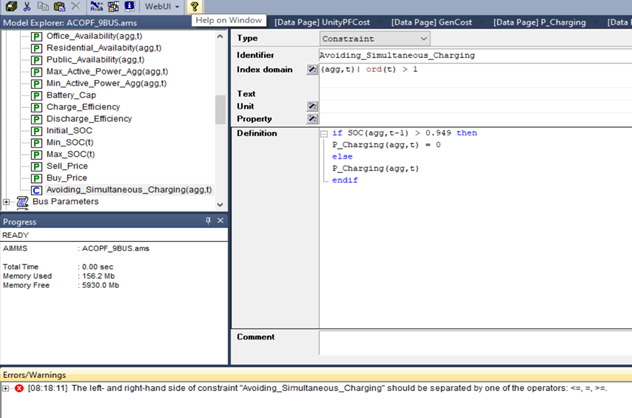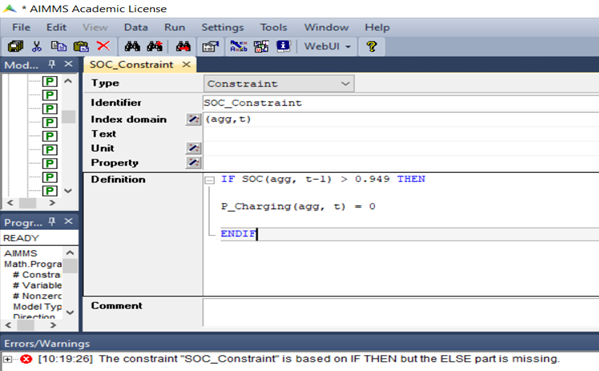Good morning all,
Please, can someone tell me why I keep getting this error ![]() ? Both SOC(agg,t) and P_Charging(agg,t) are variables.
? Both SOC(agg,t) and P_Charging(agg,t) are variables.
Thanks so much.

Best answer by mohansx
View original +3
+3
Good morning all,
Please, can someone tell me why I keep getting this error ![]() ? Both SOC(agg,t) and P_Charging(agg,t) are variables.
? Both SOC(agg,t) and P_Charging(agg,t) are variables.
Thanks so much.

Best answer by mohansx
View original
The problem is with your “else” block. This is a constraint and not a variable definition, so
else
P_Charging(agg, t)
endif
does not make any sense. You can simply have
IF SOC(agg, t-1) > 0.949 THEN
P_Charging(agg, t) = 0
ENDIF
P_Charging(agg, t) <= 0 + U2 * (1 - Y(agg, t))
will become something like
P_Charging(agg, t) >= L2 * (1 - Y(agg, t))
When Y is 0, this will be P_Charging >= L2 and when Y = 1 - P_Charging >= 0 which will force it to be P_charging = 0 because of the range L2 <= P_Charging <= 0
 +3
+3
Thanks
 +3
+3
Thanks
I tried that suggestion and it still gives error of missing “ELSE” part. Sincerely this looks so simple to tackle personally considering what I have done in AIMMS but I really dont know why I cant resolve it. Any further help would be greatly appreciated.
Thanks

Hello
Apologies, I missed that AIMMS requires IF blocks in constraints to have ELSE conditions too.
You have two options -
IF SOC(agg, t-1) > 0.949 THEN
0
ELSE
P_Charging(agg, t)
ENDIFconstraint1
SOC(agg, t-1) <= 0.949 + U1 * Y(agg, t)
constraint2
P_Charging(agg, t) <= 0 + U2 * (1 - Y(agg, t))If SOC(agg, t-1) needs to be greater than 0.949, Y(agg, t) must be 1 which will force the second constraint to become P_Charging(agg, t) <= 0 + 0 = 0 (assuming the range of P_Charging is nonnegative).
I hope this helps.
 +3
+3
Hello
Thanks for your response. My system went for some maintenance and just returned with it. I will let you know if your suggestion solves my problem.
Thanks again
Olusegun
 +3
+3
Hi
Sorry to bother you again on the above subject.
Please I want to ask what happens if range of P_Charging is nonpositive, that is it must be negative or zero?
Please, what will now be U2?
Thanks in advance for your prompt response.
Olusegun
Already have an account? Login
Please use your business or academic e-mail address to register
No account yet? Create an account
Enter your E-mail address. We'll send you an e-mail with instructions to reset your password.
Didn't find what you were looking for? Try searching on our documentation pages: